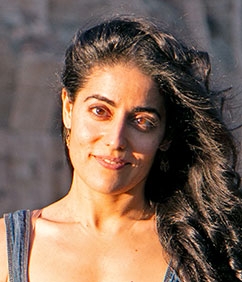In personal and professional practice, Laura Ricciardi ’08 examines the intersection of art and law
As an assistant professor of arts management at the State University of New York’s Purchase College, Laura Ricciardi ’08 researches the legal issues surrounding contested public monuments. Along with her teaching and research, Ricciardi is also a photographer, community installation artist, and painter. The intersection of her dual passions for art and academic pursuits, she says, was cultivated at NYU Law.
“The singularity of study at law school was really a breeding ground for my artistic life,” says Ricciardi. She names the Art Law course taught by Emily Kempin Professor of Law Amy Adler as instrumental in her understanding of how her artistic work and legal study could combine. “We looked at how legal questions were also philosophical questions, aesthetic questions. And that framework has guided me in my research, in how I approach the study of law, and in how I teach it.” she says. “But also it has provided a new framework for considering my own engagement as an artist.”
After earning a bachelor’s degree in history from Yale University, Ricciardi decided to pursue the law at NYU Law because she was interested in the academic rigor of legal study. “Something clicked when I took constitutional law,” says Ricciardi. “I could see how it shaped so many aspects of life in a very material way.” She notes that her poetry and photography during this time was inspired by the vibrancy of New York City.
During her 2L summer, Ricciardi worked at the entertainment startup GenArt, founded by Ian Gerard ’94. The experience confirmed her interest in pursuing a non-traditional legal career. “Because it was a startup, I got to experiment and work on a lot of different projects, and I think that kind of dynamic environment was exciting to me,” says Ricciardi. During her third year at NYU Law, Ricciardi recalls, Adler sent her a listing for an adjunct position at SUNY Purchase, teaching a class on censorship. “I remember Amy saying ‘You’d be good for this,’” says Ricciardi. She sent in a resume, and after she graduated, SUNY offered her a position.
While teaching as an adjunct professor, Ricciardi took on some side jobs that included working as a freelance writer and photographer, starting a jewelry business, and providing legal counseling to small publishing houses. “I knew that I liked academia, and so I was taking whatever odd jobs I could to make an income,” says Ricciardi who notes that she enjoyed having the freedom to explore different types of work. “It might be a personality trait of mine that I often feel reluctant to commit to doing any one thing for ever and ever, and this allowed for that,” she says. Ricciardi worked on a photography collaboration project with furniture and home décor company West Elm and volunteered with Sing for Hope, a global public art project that places pianos designed by artists in public spaces for anyone’s use.
“In my art and in my scholarship, I’m concerned with public space, with access to art, with authorship,” she says. Now in a tenure-track position at SUNY, Ricciardi teaches courses on copyright and culture as well as art and entertainment law. She focuses her academic research on public space and the monuments within them: her recent scholarship addresses the litigation surrounding Confederate monuments, including the increased controversy around them after the 2020 murder of George Floyd and the calls for racial justice that followed. “There were a number of artistic interventions that called for justice,” says Ricciardi, “and there was backlash against that. There were questions about who owns public monuments and what purpose they serve. I’m interested in mapping how those questions play out both in and outside of law.”
“The thing that is so amazing about Laura is that she truly has the spirit and mind of an artist, and she’s a brilliant lawyer, and she brings both parts of her to her work,” says Julie Ehrlich ’08, who serves as program advisor and chief of staff at the grant-making Andrew W. Mellon Foundation. Ehrlich and Ricciardi became friends at Yale before the two became classmates again at NYU Law. Recently, Ricciardi and Ehrlich found their paths crossing again when, in 2020, the Mellon Foundation committed to investing $250 million in reshaping the American commemorative landscape over the next five years and Ricciardi invited Ehrlich to speak on a panel at SUNY Purchase about the role of the arts-based activism in reimagining American monuments today.
“Laura has known for a long time that her interests didn’t put her on a well-defined path career-wise,” says Ehrlich. “It’s really thrilling, both as a friend and as a person interested in art and law and public spaces, to see that she has found a way to bring her entire creative self to bear on her work.”
In January 2022, Ricciardi will travel to the University of Messina on a Fulbright Award to study fascist-era monuments in Italy, examining how historic preservation law functions and how it influences the way citizens view these monuments and the actions that take place near them.
“I tend to approach my artistic practice and my scholarship in similar ways,” says Ricciardi. “The processes of making art and producing scholarship feel similar to me. There’s a lot of cross-pollination. Sometimes I’ll read a theoretical text, and what comes out of me is a poem.”
“And it works the other way around,” she says. “When I’m looking at something that is not necessarily related to law, suddenly I can put it into that framework and it means something different. I’m grateful to live in a world where I can continue to work in both of these spaces and let them be in conversation with each other.”
Posted October 19, 2021. Photo credit: Mark Letteney.


